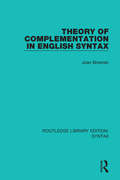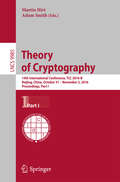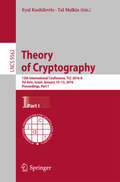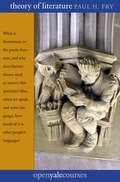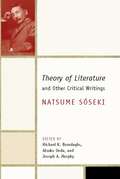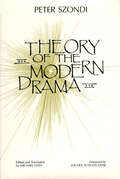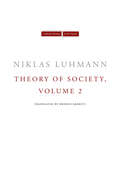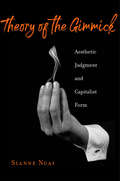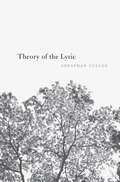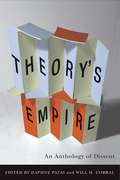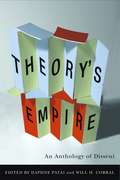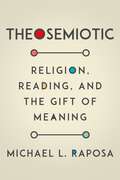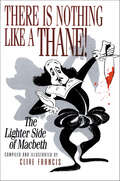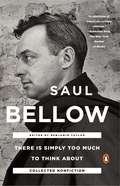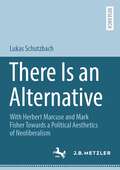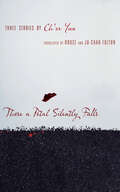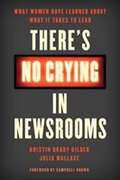- Table View
- List View
Theory of Complementation in English Syntax (Routledge Library Editions: Syntax #4)
by Joan BresnanThe subject of this study, first published in 1979, is the role of the complementizer in English syntax and its implications for syntactic theory. It is argued that the familiar transformational treatment of complementizers is inadequate, and that they must be specified in deep structure by means of a Phrase Structure rule. This title will be of interest to students of language and linguistics.
Theory of Cryptography
by Adam Smith Martin HirtThe two-volume set LNCS 9985 and LNCS 9986 constitutes the refereed proceedings of the 14th International Conference on Theory of Cryptography, TCC 2016-B, held in Beijing, China, in November 2016. The total of 45 revised full papers presented in the proceedings were carefully reviewed and selected from 113 submissions. The papers were organized in topical sections named: TCC test-of-time award; foundations; unconditional security; foundations of multi-party protocols; round complexity and efficiency of multi-party computation; differential privacy; delegation and IP; public-key encryption; obfuscation and multilinear maps; attribute-based encryption; functional encryption; secret sharing; new models.
Theory of Cryptography
by Adam Smith Martin HirtThe two-volume set LNCS 9985 and LNCS 9986 constitutes the refereed proceedings of the 14th International Conference on Theory of Cryptography, TCC 2016-B, held in Beijing, China, in November 2016. The total of 45 revised full papers presented in the proceedings were carefully reviewed and selected from 113 submissions. The papers were organized in topical sections named: TCC test-of-time award; foundations; unconditional security; foundations of multi-party protocols; round complexity and efficiency of multi-party computation; differential privacy; delegation and IP; public-key encryption; obfuscation and multilinear maps; attribute-based encryption; functional encryption; secret sharing; new models.
Theory of Cryptography
by Tal Malkin Eyal KushilevitzThe two-volume set LNCS 9562 and LNCS 9563 constitutes the refereed proceedings of the 13th International Conference on Theory of Cryptography, TCC 2016, held in Tel Aviv, Israel, in January 2016. The 45 revised full papers presented were carefully reviewed and selected from 112 submissions. The papers are organized in topical sections on obfuscation, differential privacy, LWR and LPN, public key encryption, signatures, and VRF, complexity of cryptographic primitives, multiparty computation, zero knowledge and PCP, oblivious RAM, ABE and IBE, and codes and interactive proofs. The volume also includes an invited talk on cryptographic assumptions.
Theory of Cryptography
by Tal Malkin Eyal KushilevitzThe two-volume set LNCS 9562 and LNCS 9563 constitutes the refereed proceedings of the 13th International Conference on Theory of Cryptography, TCC 2016, held in Tel Aviv, Israel, in January 2016. The 45 revised full papers presented were carefully reviewed and selected from 112 submissions. The papers are organized in topical sections on obfuscation, differential privacy, LWR and LPN, public key encryption, signatures, and VRF, complexity of cryptographic primitives, multiparty computation, zero knowledge and PCP, oblivious RAM, ABE and IBE, and codes and interactive proofs. The volume also includes an invited talk on cryptographic assumptions.
Theory of Language
by Steven E. Weisler Slavko MilekicIn this introductory-level linguistics text, Steven E. Weisler and Slavko Milekic develop a theoretically motivated analysis of language with an emphasis on grammar construction and argumentation. They introduce the theory of language, sounds, words, sentences, and meaning, as well as language and the brain.
Theory of Literature
by Paul H. FryBringing his perennially popular course to the page, Yale University Professor Paul H. Fry offers in this welcome book a guided tour of the main trends in twentieth-century literary theory. At the core of the book's discussion is a series of underlying questions: What is literature, how is it produced, how can it be understood, and what is its purpose? Fry engages with the major themes and strands in twentieth-century literary theory, among them hermeneutics, modes of formalism, semiotics and Structuralism, deconstruction, psychoanalytic approaches, Marxist and historicist approaches, theories of social identity, Neo-pragmatism and theory. By incorporating philosophical and social perspectives to connect these many trends, the author offers readers a coherent overall context for a deeper and richer reading of literature.
Theory of Literature and Other Critical Writings (Weatherhead Books on Asia)
by Sōseki NatsumeNatsume Soseki (1867-1916) was the foremost Japanese novelist of the twentieth century, known for such highly acclaimed works as Kokoro, Sanshiro, and I Am a Cat. Yet he began his career as a literary theorist and scholar of English literature. In 1907, he published Theory of Literature, a remarkably forward-thinking attempt to understand how and why we read. The text anticipates by decades the ideas and concepts of formalism, structuralism, reader-response theory, and postcolonialism, as well as cognitive approaches to literature that are only now gaining traction. Employing the cutting-edge approaches of contemporary psychology and sociology, Soseki created a model for studying the conscious experience of reading literature as well as a theory for how the process changes over time and across cultures. Along with Theory of Literature, this volume reproduces a later series of lectures and essays in which Soseki continued to develop his theories. By insisting that literary taste is socially and historically determined, Soseki was able to challenge the superiority of the Western canon, and by grounding his theory in scientific knowledge, he was able to claim a universal validity.
Theory of Modern Drama: A Critical Edition
by Peter SzondiTheory of the Modern Drama is a brilliant analysis of the emergence and development of modern drama from the Renaissance to the present day. Szondi shows how the rise of modern drama was linked to broader social processes and expressed some of the beliefs characteristic of early modern Europe. This was manifested in the convention that form was ahistorical and it simply required the appropriate subject matter to do justice to the form. But in the late nineteenth century the form of drama began to change, giving rise to the new types of drama characteristic of the twentieth century. Szondi offers a highly original interpretation of this transformation, linking it with the emergence of an epic form which emphasizes the isolation of the individual. This concise but wide-ranging book discusses the work of Ibsen, Chekhov, Strindberg, Sartre, Brecht and Wilder, among others. It will be essential reading for students of drama, modern languages and literature, and contemporary literary theory.
Theory of Quantum Computation, Communication, and Cryptography
by Dave Bacon Miguel Martin-Delgado Martin RoettelerThis book constitutes the thoroughly refereed post-conference proceedings of the 6th Conference on Theory of Quantum Computation, Communication, and Cryptography, TQC 2011, held in Madrid, Spain, in May 2011. The 14 revised papers presented were carefully selected from numerous submissions. The papers present new and original research and cover a large range of topics in quantum computation, communication and cryptography, a new and interdisciplinary field at the intersection of computer science, information theory and quantum mechanics.
Theory of Racelessness: A Case for Antirace(ism) (African American Philosophy and the African Diaspora)
by Sheena Michele MasonThis book presents a skeptical eliminativist philosophy of race and the theory of racelessness, a methodological and pedagogical framework for analyzing "race" and racism. It explores the history of skeptical eliminativism and constructionist eliminativism within the history of African American philosophy and literary studies and its consistent connection with movements for civil rights. Sheena M. Mason considers how current anti-racist efforts reflect naturalist conservationist and constructionist reconstructionist philosophies of race that prevent more people from fully confronting the problem of racism, not race, thereby enabling racism to persist. She then offers a three-part solution for how scholars and people aspiring toward anti-racism can avoid unintentionally upholding racism, using literary studies as a case study to show how "race" often translates into racism itself. The theory of racelessness helps more people undo racism by undoing the belief in "race."
Theory of Society, Volume 2
by Niklas Luhmann translated by Rhodes BarrettThis second volume of Niklas Luhmanns two-part final work was first published in German in 1997. The culmination of his thirty-year theoretical project to reconceptualize sociology, it offers a comprehensive description of modern society. Beginning with an account of the fluidity of meaning and the accordingly high improbability of successful communication, Luhmann analyzes a range of communicative media, including language, writing, the printing press, and electronic media, as well as "success media," such as money, power, truth, and love, all of which structure this fluidity and make communication possible. The book asks what gives rise to functionally differentiated social systems, how they evolve, and how social movements, organizations, and patterns of interaction emerge. The advent of the computer and its networks, which triggered potentially far-reaching processes of restructuring, receives particular attention. A concluding chapter on the semantics of modern societys self-description bids farewell to the outdated theoretical approaches of "old Europe"--that is, to ontological, holistic, ethical, and critical interpretations of society--and argues that concepts such as "the nation," "the subject," and "postmodernity" are vastly overrated. In their stead, "society"--long considered a suspicious term by sociologists, one open to all kinds of reification--is defined in purely operational terms. It is the always uncertain answer to the question of what comes next in all areas of communication.
Theory of the Gimmick: Aesthetic Judgment and Capitalist Form
by Sianne NgaiA provocative theory of the gimmick as an aesthetic category steeped in the anxieties of capitalism. Repulsive and yet strangely attractive, the gimmick is a form that can be found virtually everywhere in capitalism. It comes in many guises: a musical hook, a financial strategy, a striptease, a novel of ideas. Above all, acclaimed theorist Sianne Ngai argues, the gimmick strikes us both as working too little (a labor-saving trick) and as working too hard (a strained effort to get our attention). Focusing on this connection to work, Ngai draws a line from gimmicks to political economy. When we call something a gimmick, we are registering uncertainties about value bound to labor and time—misgivings that indicate broader anxieties about the measurement of wealth in capitalism. With wit and critical precision, Ngai explores the extravagantly impoverished gimmick across a range of examples: the fiction of Thomas Mann, Helen DeWitt, and Henry James; photographs by Torbjørn Rødland; the video art of Stan Douglas; the theoretical writings of Stanley Cavell and Theodor Adorno. Despite its status as cheap and compromised, the gimmick emerges as a surprisingly powerful tool in this formidable contribution to aesthetic theory.
Theory of the Lyric
by Jonathan CullerWhat sort of thing is a lyric poem? An intense expression of subjective experience? The fictive speech of a specifiable persona? Theory of the Lyric reveals the limitations of these two conceptions of the lyric-the older Romantic model and the modern conception that has come to dominate the study of poetry-both of which neglect what is most striking and compelling in the lyric and falsify the long and rich tradition of the lyric in the West. Jonathan Culler explores alternative conceptions offered by this tradition, such as public discourse made authoritative by its rhythmical structures, and he constructs a more capacious model of the lyric that will help readers appreciate its range of possibilities. Theory of the Lyric constitutes a major advance in our understanding of the Western lyric tradition. Examining ancient as well as modern poems, from Sappho to Ashbery, in many European languages, Culler underscores lyric's surprising continuities across centuries of change-its rhythmical resources, its strange modes of address, its use of the present tense, and the intriguing tension between its ritualistic and fictional dimensions. He defends the idea of lyric as a genre against recent critiques, arguing that lyrics address our world rather than project a fictional world and also challenging the strongly established assumption that poems exist to be interpreted. Theory of the Lyric concludes with a discussion of how to conceive the relations between lyric and society in ways that would acknowledge and respond to lyric's enduring powers of enchantment.
Theory of the Novel
by Guido MazzoniIn his theory of the novel, Guido Mazzoni explains that novels consist of stories told in any way whatsoever about the experiences of ordinary men and women who exist as contingent beings within time and space. Novels allow readers to step into other lives and other versions of truth, each a small, local world, absolute in its particularity.
Theory's Empire: An Anthology of Dissent
by Daphne Patai Will H. CorralNot too long ago, literary theorists were writing about the death of the novel and the death of the author; today many are talking about the death of Theory. Theory, as the many theoretical ism's (among them postcolonialism, postmodernism, and New Historicism) are now known, once seemed so exciting but has become ossified and insular. This iconoclastic collection is an excellent companion to current anthologies of literary theory, which have embraced an uncritical stance toward Theory and its practitioners. Written by nearly fifty prominent scholars, the essays in Theory's Empire question the ideas, catchphrases, and excesses that have let Theory congeal into a predictable orthodoxy. More than just a critique, however, this collection provides readers with effective tools to redeem the study of literature, restore reason to our intellectual life, and redefine the role and place of Theory in the academy.
Theory's Empire: An Anthology of Dissent
by Daphne Patai Wilfrido CorralNot too long ago, literary theorists were writing about the death of the novel and the death of the author; today many are talking about the death of Theory. Theory, as the many theoretical ism's (among them postcolonialism, postmodernism, and New Historicism) are now known, once seemed so exciting but has become ossified and insular. This iconoclastic collection is an excellent companion to current anthologies of literary theory, which have embraced an uncritical stance toward Theory and its practitioners. Written by nearly fifty prominent scholars, the essays in Theory's Empire question the ideas, catchphrases, and excesses that have let Theory congeal into a predictable orthodoxy. More than just a critique, however, this collection provides readers with effective tools to redeem the study of literature, restore reason to our intellectual life, and redefine the role and place of Theory in the academy.
Theosemiotic: Religion, Reading, and the Gift of Meaning
by Michael L. RaposaIn Theosemiotic, Michael Raposa uses Charles Peirce’s semiotic theory to rethink certain issues in contemporary philosophical theology and the philosophy of religion. He first sketches a history that links Peirce’s thought to that of earlier figures (both within the tradition of American religious thought and beyond), as well as to other classical pragmatists and to later thinkers and developments. Drawing on Peirce’s ideas, Raposa develops a semiotic conception of persons/selves emphasizing the role that acts of attention play in shaping human inferences and perception. His central Peircean presuppositions are that all human experience takes the form of semiosis and that the universe is “perfused” with signs. Religious meaning emerges out of a process of continually reading and re-reading certain signs.Theology is explored here in its manifestations as inquiry, therapy, and praxis. By drawing on both Peirce’s logic of vagueness and his logic of relations, Raposa makes sense out of how we talk about God as personal, and also how we understand the character of genuine communities. An investigation of what Peirce meant by “musement” illuminates the nature and purpose of prayer. Theosemiotic is portrayed as a form of religious naturalism, broadly conceived. At the same time, the potential links between any philosophical theology conceived as theosemiotic and liberation theology are exposed.
Therapy as Discourse: Practice and Research (The Language of Mental Health)
by Tom Strong Olga SmoliakThis book addresses the premise that therapy can be understood, practiced, and researched as a discursive activity. Using varied forms of discourse analysis, it examines the cultural, institutional, and face-to-face communications that shape, and occur within, therapies that are discursively understood and practiced. By first providing an overview of commonalities across discursive therapies and research approaches, the authors discursively examine general aspects of therapy. Topics explored include subjectivity, psychological terms, institutional influences, therapeutic relationships, therapists’ ways of talking and questioning, discursive ethics, and assessment of therapeutic processes and outcomes. This book offers a macro-analysis of the conversational practices of a discursively informed approach to therapy; as well as a micro-analysis of the ways in which language shapes and is used in a discursively informed approach to therapy. This book will interest practitioners seeking to better understand therapy as a discursive process, and discourse analysts wanting to understand therapy as discursive therapists might practice it.
There Is Nothing Like a Thane!: The Lighter Side of Macbeth
by Clive FrancisThere is Nothing Like a Thane is a follow-up to Clive Francis's highly successful There is Nothing Like a Dane! The Lighter Side of Hamlet. Thane is a hilarious compilation of unintentional funny moments from a variety of productions of Macbeth - interwoven with Francis's witty caricatures. It also delves into the many superstitions, which have dogged the play since 1603, making it possibly the unluckiest play ever writtenWe hear of how some actors fared better than others when playing the role of the Thane. If Ralph Richardson's was the worst, Peter O'Toole's was certainly the funniest. Olivier was deemed the greatest, John Gielgud the must successful, and Charles Laughton the silliest. We also hear from Orson Welles, David Garrick, Charles Dickens and William McGonagall - who refused to die for fear of upsetting his audience. Not to be outdone we shall hear from a number of Lady Macbeths as well, including Sybil Thorndike, who'd pray every night in the wings so as to ward away evil spirits. This is a book for all those who love the theater, especially the Bard.
There Is Simply Too Much to Think About: Collected Nonfiction
by Saul Bellow Benjamin Taylor“Bellow’s nonfiction has the same strengths as his stories and novels: a dynamic responsiveness to character, place and time (or era) . . . And you wonder—what other highbrow writer, or indeed lowbrow writer has such a reflexive grasp of the street, the machine, the law courts, the rackets?” —Martin Amis, The New York Times Book ReviewThe year 2015 marks several literary milestones: the centennial of Saul Bellow’s birth, the tenth anniversary of his death, and the publication of Zachary Leader’s much anticipated biography. Bellow, a Nobel Laureate, Pulitzer Prize winner, and the only novelist to receive three National Book awards, has long been regarded as one of America’s most cherished authors. Here, Benjamin Taylor, editor of the acclaimed Saul Bellow: Letters, presents lesser-known aspects of the iconic writer.Arranged chronologically, this literary time capsule displays the full extent of Bellow’s nonfiction, including criticism, interviews, speeches, and other reflections, tracing his career from his initial success as a novelist until the end of his life. Bringing together six classic pieces with an abundance of previously uncollected material, There Is Simply Too Much to Think About is a powerful reminder not only of Bellow’s genius but also of his enduring place in the western canon and is sure to be widely reviewed and talked about for years to come.From the Hardcover edition.
There Is an Alternative: With Herbert Marcuse and Mark Fisher Towards a Political Aesthetics of Neoliberalism
by Lukas SchutzbachThe book aims at interrogating the contemporary problematic of neoliberalism and its relationship to culture and ideology through the lens of a theoretical synthesis interweaving the emancipatory aesthetics of Herbert Marcuse, Fredric Jameson's pathbreaking analysis of the cultural logic of late capitalism, and the late Mark Fisher's work on "post-capitalist desire" and "acid communism." The main imperative is to formulate a possible (and, as it turns out, necessary) opening for aesthetic critique in the climate of contemporary neoliberal capitalism. This mode of aesthetic critique is then operationalized through an exemplary reading of the emancipatory poetics of Ben Lerner's 2014 novel "10:04."
There Plant Eyes: A Personal and Cultural History of Blindness
by M. Leona GodinFrom Homer to Helen Keller, from Dune to Stevie Wonder, from the invention of braille to the science of echolocation, M. Leona Godin explores the fascinating history of blindness, interweaving it with her own story of gradually losing her sight. There Plant Eyes probes the ways in which blindness has shaped our ocularcentric culture, challenging deeply ingrained ideas about what it means to be &“blind.&” For millennia, blindness has been used to signify such things as thoughtlessness (&“blind faith&”), irrationality (&“blind rage&”), and unconsciousness (&“blind evolution&”). But at the same time, blind people have been othered as the recipients of special powers as compensation for lost sight (from the poetic gifts of John Milton to the heightened senses of the comic book hero Daredevil). Godin—who began losing her vision at age ten—illuminates the often-surprising history of both the condition of blindness and the myths and ideas that have grown up around it over the course of generations. She combines an analysis of blindness in art and culture (from King Lear to Star Wars) with a study of the science of blindness and key developments in accessibility (the white cane, embossed printing, digital technology) to paint a vivid personal and cultural history. A genre-defying work, There Plant Eyes reveals just how essential blindness and vision are to humanity&’s understanding of itself and the world.
There a Petal Silently Falls: Three Stories by Ch'oe Yun (Weatherhead Books on Asia)
by Ch'Oe YunCh'oe Yun is a Korean author known for her breathtaking versatility, subversion of authority, and bold exploration of the inner life. Readers celebrate her creative play with fantasy and admire her deep engagement with trauma, history, and the vagaries of remembrance.In this collection's title work, There a Petal Silently Falls, Ch'oe explores both the genesis and the aftershocks of historical outrages such as the Kwangju Massacre of 1980, in which a reported 2,000 civilians were killed for protesting government military rule. The novella follows the wanderings of a girl traumatized by her mother's murder and strikes home the injustice of state-sanctioned violence against men and especially women. "Whisper Yet" illuminates the harsh treatment of leftist intellectuals during the years of national division, at the same time offering the hope of reconciliation between ideological enemies. The third story, "The Thirteen-Scent Flower," satirizes consumerism and academic rivalries by focusing on a young man and woman who engender an exotic flower that is coveted far and wide for its various fragrances. Elegantly crafted and quietly moving, Ch'oe Yun's stories are among the most incisive portrayals of the psychological and spiritual reality of post-World War II Korea. Her fiction, which began to appear in the late 1980s, represents a turn toward a more experimental, deconstructionist, and postmodern Korean style of writing, and offers a new focus on the role of gender in the making of Korean history.
There's No Crying In Newsrooms: What Women Have Learned About What It Takes To Lead
by Julia Ann Wallace Kristin Grady GilgerThere’s No Crying in Newsrooms tells the stories of remarkable women who broke through barrier after barrier at media organizations around the country over the past four decades. They started out as editorial assistants, fact checkers and news secretaries and ended up running multi-million-dollar news operations that determine a large part of what Americans read, view and think about the world. These women, who were calling in news stories while in labor and parking babies under their desks, never imagined that 40 years later young women entering the news business would face many of the same battles they did – only with far less willingness to put up and shut up. The female pioneers in “There’s No Crying in Newsrooms” have many lessons to teach about what it takes to succeed in media or any other male-dominated organization, and their message is more important now than ever before. « Less
